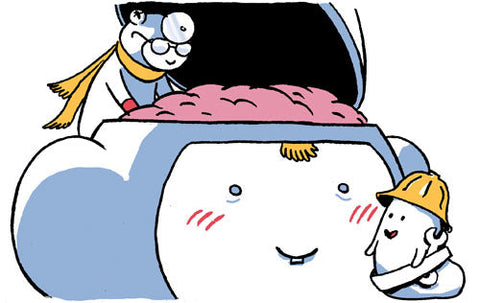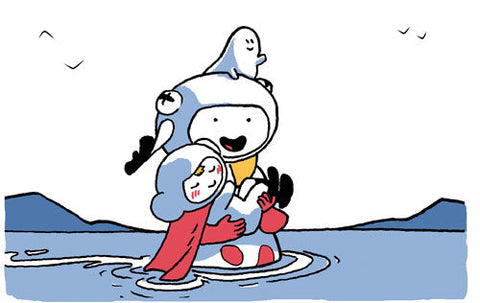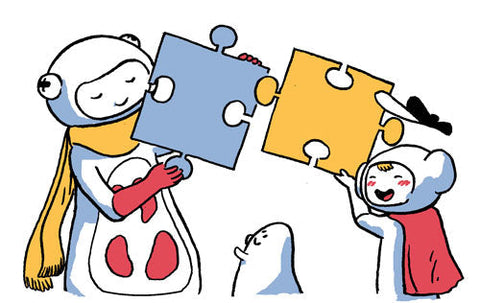Building an effective team is crucial for designing great products. Every team is unique, but there are some common traits in those that are most successful.
Emulate those traits with these six vital components of a great product team.
1. Create an environment of psychological safety
Great teams have bold ideas and tentatively held opinions. Psychological safety is crucial to helping them share those ideas and challenge opinions.
Putting your “it’s crazy, but it just might work” thoughts out there leaves you vulnerable to criticism. The best teams cultivate a safe environment where everyone feels comfortable with that vulnerability.
Criticism is something these teams actively seek. Not avoid. The only way to achieve this is to remove the ego at all costs. Without ego, you are open to exploring ideas without ridicule.
A psychologically safe environment helps build trust. Trust is more than believing somebody’ll catch if you fall. It allows you to make quicker group decisions, knowing your comrades are working together for the good of the team.
It’s easy to be bold when you don’t have to cover your ass or dodge blame when things don’t quite go according to plan. And bold teams go far.
So how do you create that safe environment and allow creativity to bloom and make bold decisions?
- Enforce a strong culture of ‘no such thing as silly questions - or stupid ideas’.
- Avoid blame; sometimes things go wrong, and there’s always a lesson in it if you look hard enough. Lack of blame doesn’t have to mean a lack of accountability. If someone’s expert opinion misses the mark once, it’s unlikely to do so a second time.
- Encourage giving and receiving of feedback. A simple question like “how do you think that could’ve gone better?” is a small step to fostering that feedback culture.
- Be present. Don’t interrupt and listen. Show you have done so by asking thoughtful questions that help you learn more.
- Start sessions with a check-in to see how people are feeling. It helps remind everyone that they are in a safe environment.
The effects of these behaviours compound. Practice them often, and the more habitual they become. Leading by example means going first, and showing what is right behaviour.
2. Keep the team small
Amazon has a simple rule of thumb: teams should be small enough that two large pizzas could feed them. One million employees, yet each team has fewer than ten people.
The best teams leave their job titles at the door and share the burden of the goal. Democratised effort builds a feeling of shared ownership of the work. The bonus side effect is a shared understanding, which means no documentation for the sake of it. Only small teams can get away with fast-paced work without the need to write down what they’re doing.
So how do you keep a team size down?
Start small and keep it that way. Only add new members when you have a skill gap to fill. But only if the skill can’t be learned by the team - either due to time or complexity.
3. Have a clear goal to work towards
Your small, efficient team might be able to move quickly. But what direction are they pulling in?
Having one clear goal to work towards might sound obvious - but it’s harder than you think. Even teams with a clear destination may have different ideas about the best way to get there.
A team that knows where they are going - and why - will find it easier to prioritise their work. A goal that they understand and believe in is a powerful motivator—opposed to a goal that is unclear and that they don’t care for.
A leader does not set the best goals; the group does. A leader is only there to facilitate that decision. People tend to not care about goals that senior leadership didn’t involve them in setting.
Objectives and Key Results (OKR) is a great framework to get a team working together on a shared end-state. It centres around the idea of radical focus. One single goal for the quarter ahead.
How often do you get sidetracked by urgent tasks that appear out of nowhere? We are easily distracted, and the beauty of OKRs is it demands you avoid those distractions. It requires you call out and remove any tasks not moving the team toward their goal.
If your team is fuzzy on what the goal is, learn what everyone thinks it should be with the Sailboat exercise. This tactic also helps your team see what the obstacles are to achieving it.
Once you’re clear on where you are going, it helps to make a precise plan of how you are going to get there. Work backwards from your goal with Sticky Steps.
4. Create a culture of feedback
Your team is your most valuable asset, so invest in them. Nurture bonds by coming together regularly to reflect on how to improve.
The most common way agile teams do this is with retrospective meetings. These sessions look back at the past two weeks to see what could’ve gone better, and what’s gone well.
Retrospectives can make a room feel tense. But it’s vital to help the team develop. It takes a lot of guts to stand up and say what didn’t go well, or address the elephant in the room.
Group reflection gives the team catharsis. By looking at what happened, a team can talk about the possibilities of how to improve for next time. Regular retros not only develop the team but evolve the product too.
In a trusting team, there is no greater tool for improvement than honest, humble feedback. There’s a lot you can learn about giving feedback from FBI negotiators. Again, a culture of feedback is only possible when lead by example. So make it clear you welcome feedback by asking for it often.
Celebrate successes every week, even if things that haven’t gone so well overshadowed them. Effort and camaraderie are always worth celebrating. Showing gratitude creates a healthier culture than only praising good outcomes. Because when things go south, you won’t have a reason to cheer. But when you revere effort, there always is.
Aside from group reflection, it’s important to have one-to-one chats. Schedule these regularly with your team, and encourage them to do the same. The early embers of mentorships start here.
5. Understand what each person gains from their team’s success
At work - and in life - people are driven by different motivations. A diverse team will include people with a wide range of desires and purposes. By understanding what drives people, you can help tie your group objectives with their own.
People are often motivated at work by the following things:
- Mastery - the ability to develop their skills and learn new ones.
- Autonomy - where they feel responsible for their actions and their success.
- Purpose - a personal alignment with the desired outcomes of the project.
Work with each person to create a personally rewarding role, that also aligns with the team’s goal.
6. Hire from diverse backgrounds
Diversity improves outcomes is repeatedly proven. Yet it is often an afterthought. Designing a team for success means putting diversity at the forefront—a variety of ideas, skills, background, culture and race.
A team of people similar to each other will come up with similar solutions. But a team with a mix of backgrounds will be able to solve problems from more angles.
Not only that, but the individuals in your group will learn so much more from each other.
To get the best results from a diverse team:
- Identify each individual’s unique motivations (see tip 5)
- Ensure everyone has a well-defined role (so that they can contribute value)
- Work on creating psychological safety (see tip 1).
Please don’t leave it to chance; remove any data that could be subject to bias from job applications. Be aware of your own unconscious biases. Harvard University has a series of tests you can take to examine whether or not you subconsciously favour certain groups of people. You likely do. Even being aware of this is essential. As it means you now have the impetus to act on this knowledge.
Summary
The process of building a product team is one of the most important processes you will undertake. So it’s crucial to get it right.
- Trust your team to do the right thing, and learn together as a team when things go wrong.
- Invest time in the team coming together and learning how to work with each other. Keep on doing this.
- Teams are complex; they change over time, and are fragile and take ongoing effort.
- Choose a small, diverse group of people and get to know what makes them tick.
- Create a safe, supportive team environment where feedback is plentiful and welcomed. Master this, and you’ll be well on your way to achieving your team’s ambitious goal.
Next steps
Check out the Team Time workshop session that helps give new teams the best chance of success.
Hat tip to Tom Adams for his contribution to this article.









